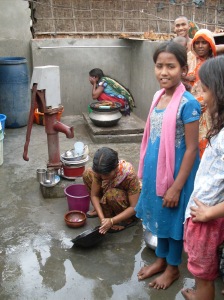Precious Water
Children entering into the school environment are encouraged to become “People who work for the common good, in particular sustaining and improving natural and social environments” (Ministerial Council on Educational, Employment, Training and Youth Affairs, 2008, p. 9). However, I argue for this goal to encompass younger children who have not yet started school.
Due to early childhood being widely identified as the most significant growth period in a child’s life, it is also an optimal period for shaping environmental knowledge, attitudes and practices (Davis, 2008).
The following statement from a four year old in a Child Care setting is one of the contributing factors for developing learning opportunities based on Global Education’s ‘Water for life’ resource (n.d ), to help embed sustainability into children’s daily routines and practices.
“The taps been left on again!”
Where to begin?
Gathering children together and asking them to identify what they have used water for today. Prompt discussion with roleplaying what water may have been used for example brushing teeth and washing hands. Draw simple pictures on whiteboard to record their answers. To extend children’s thinking draw a simple map of the centre and go for a walk (indoors & outdoors) label where water is used. Ask children to imagine waking up tomorrow morning and there is no water in our taps! Which uses of water are most important? Why? (Exploring the question where does water in our taps come from? And where does it go, could be explored as another investigation task).
Gather children again and read through UNICEFs photo story ‘The Long Walk’ (2012). This is a story of Elezete, one of many children in Timor Leste who spend hours every day walking to collect water.
Bradbery (2013) emphasises how picture books can be an influential tool to help young children to “Assume responsibility for creating and enjoying a sustainable future through global citizenship” (p.221) and begin to identify, examine and even change personal routines to contribute to creating sustainable futures.
Show children a variety of photos of people around the world collecting and using water. Discuss how the water is being collected, who is collecting it, how easy or difficult might it be. Having children explore the weight of a 1 or 2 litre container of water and what this amount of water could be used for could lead to early understandings of the impact that having to collect water could have on other children’s lives.

A woman washes her clothes near her home in Kampala, Uganda. Waste water flows away in the open drain

WaterAid has provided a water supply, toilets and proper drainage to the Dalit community living in informal settlements in Dhaka, Bangladesh
Brainstorm with children ways that water use could be reduced at the centre. What could you say to people who leave a tap running? Why do you think it’s important?
Why is Education for Sustainability (EfS) a priority for me?
Our future depends on it: the challenge for us all is obtaining a healthy balance of environmental, social and economic systems that promote a just and sustainable future for generations to come. Of particular concern to me, is the increasing rate of resource consumption and environmental degradation and the flow-on effects this has locally, nationally and globally. It is widely recognised that education is one of the key contributing factors to becoming change agents, therefore it is imperative that (EfS) begins in early childhood and that Educators and children are discussing and exploring the concept that all living things are interconnected (DEEWR, 2009).
References
Bradbery, D. (2013). Bridges to Global Citizenship: Ecologically Sustainable Futures Utilising Children’s Literature in Teacher Education. Australian Journal of Environmental Education, 29(2), 221–237. doi 10.1017/aee.2014.7
Davis, J,. M. (2008). What might education for sustainability look like in early childhood? A case for participatory, whole-of-settings approaches. (p.18). The Contribution of Early Childhood Education to a Sustainable Society, UNESCO. Retrieved from http://unesdoc.unesco.org/images/0015/001593/159355E.pdf
Department of Education, Employment and Workplace Relations. (2009). Belonging, being and becoming, the early years learning framework for Australia. Retrieved March 23, 2015 from https://docs.education.gov.au/system/files/doc/other/belonging_being_and_becoming_the_early_years_learning_framework_for_australia.pdf
Global Education (n.d). Teacher resources to encourage a global perspectives across the curriculum: Water for life. Retrieved April 2, 2015, from http://www.globaleducation.edu.au/teaching-activity/water-for-life-f-2.html
Ministerial Council on Educational, Employment, Training and Youth Affairs (MCEETYA). (2008). Melbourne declaration on educational goals for young Australians. Melbourne: Author. Retrieved from http://www.curriculum.edu.au/verve/_resources/national_declaration_on_the_educational_goals_for_young_australians.pdf




Hey Tracey, your blog looks great! I really like how you have included a dramatic element into your lesson sequence by getting the children to role play how they have used water 🙂
I have also used UNICEF’s ‘The long walk’ photo story in my lesson sequence as part of my integrating the curriculum blog. There are some very powerful and beautiful resources on the UNICEF site isn’t there 🙂
Warm Regards,
Jodi
LikeLike
Thanks Jodi for the feedback I shall pop into your blog and have a look. Yes the UNICEF has been a great website for gathering resources in particular for younger students. I am keen to adapt them even further for 3 & 4 yr olds 🙂
Cheers
Tracey
LikeLike